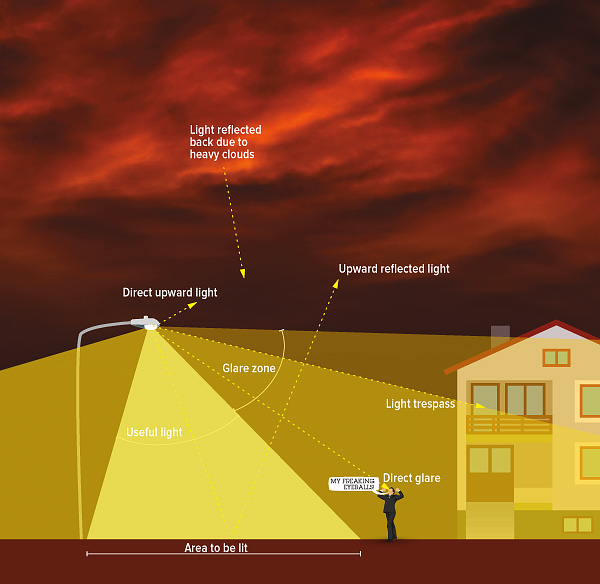Light Pollution affecting our Environment!
For billions of years, all life has relied on Earth’s predictable rhythm of day and night. It’s encoded in the DNA of all plants and animals. Humans have radically disrupted this cycle by lighting up the night.
Plants and animals depend on Earth’s daily cycle of light and dark rhythm to govern life-sustaining behaviors such as reproduction, nourishment, sleep and protection from predators.
 |
Scientific evidence suggests that artificial light at night has negative and deadly effects on many creatures including amphibians, birds, mammals, insects and plants.
|
- NOCTURNAL WILDLIFE: Nocturnal animals sleep during the day and are active at night. Light pollution radically alters their nighttime environment by turning night into day.According to research scientist Christopher Kyba, for nocturnal animals, “the introduction of artificial light probably represents the most drastic change human beings have made to their environment.”“Predators use light to hunt, and prey species use darkness as cover,” Kyba explains “Near cities, cloudy skies are now hundreds, or even thousands of times brighter than they were 200 years ago. We are only beginning to learn what a drastic effect this has had on nocturnal ecology.”
- Glare from artificial lights can also impact wetland habitats that are home to amphibians such as frogs and toads, whose nighttime croaking is part of the breeding ritual. Artificial lights disrupt this nocturnal activity, interfering with reproduction and reducing populations.
- DEMISE OF BABY SEA TURTLES: Nesting turtles once had no trouble finding a quiet, dark beach on which to nest, but now they must compete with tourists, businesses and coastal residents for use of sandy beaches. U.S. beaches, popular with humans and turtles alike, are now lined with seaside condominiums, houses and hotels. Lights from these developments discourage females from nesting. If a female fails to nest after multiple false crawls, she will resort to less-than-optimal nesting spots or deposit her eggs in the ocean. In either case, the survival outlook for hatchlings is slim.
Lighting near the shore also can cause hatchlings to become disoriented and wander inland, where they often die of dehydration or predation. Hatchlings, scientists believe, have an innate instinct that leads them in the brightest direction, which is normally moonlight reflecting off of the ocean. Excess lighting from the nearshore buildings and streets draw hatchlings toward land, where they may be eaten, run over, or drown swimming pools. While it might seem like a difficult problem to tackle, an estimated one third of all lighting in the U.S. is wasted. With an annual expenditure of about 30 million barrels of oil and 2 million tons of coal on unnecessary lights, the cost of the wasted lighting equals about $2 billion each year!
Source: Sea Turtle Conservancy
- MIGRATION: Birds that migrate or hunt at night navigate by moonlight and starlight. Artificial light can cause them to wander off course and toward the dangerous nighttime landscapes of cities. Every year millions of birds die colliding with needlessly illuminated buildings and towers. Migratory birds depend on cues from properly timed seasonal schedules. Artificial lights can cause them to migrate too early or too late and miss ideal climate conditions for nesting, foraging and other behaviors.
Source: internationaldarksky.org
Video : How light pollution affects our surrounding wildlife and environment. By Dnews.
Comments
Post a Comment